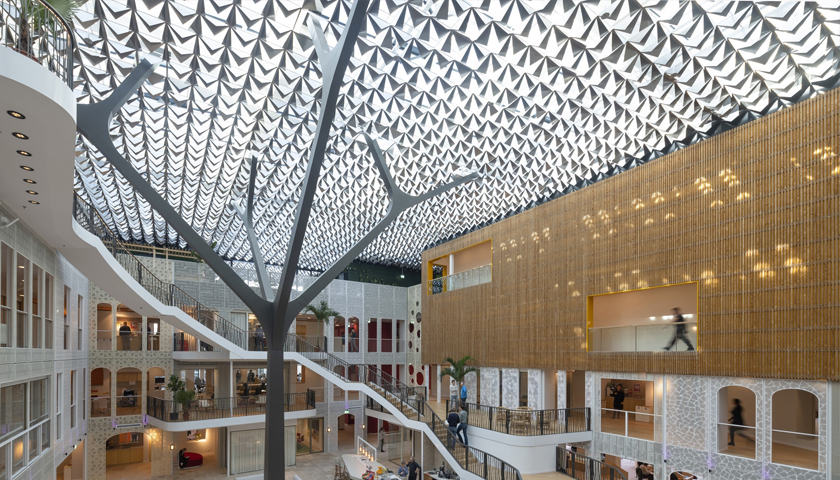The new Dutch Charity Lottery office, located in the trendy Zuidas business district of Amsterdam, has been completed only recently, but already the building is famous in the city for its stunning design.
While the eye-catching, custom-designed ceiling leaf canopy gracing the atrium and entrance forecourt has captured people’s imaginations, the complex technical innovations, developed by Hunter Douglas Architectural to enable the design to become a reality, tell a story of engineering prowess.
Designed by architectural firm Benthem Crouwel of Amsterdam, the building, formerly a neglected old office, has been rated BREEAM Outstanding, thanks to the sustainability aspects of the design and the materials chosen during the construction process. The design and installation of the atrium and entrance ceiling were a critical aspect.
Terry Woudenberg, project adviser at Hunter Douglas Architectural, was closely involved in translating the architect’s design for the canopy into technical solutions and says the custom-made ceiling demonstrates that it has the expertise to produce complex ceilings for even the most challenging situations.
“The architects’ idea was to create a leaf motif in the ceiling that creates light similar to that of a leafy environment,” he says. “Both inside and outside, the steel columns of the supporting structure have the irregular shapes of trees and branches. A canopy-like ceiling was the obvious next step.”
The design is based on four triangular leaves folded down in different angles and Hunter Douglas Architectural designed and produced a flat ceiling, using 3,500m2 of roof panels, ensuring both the inside and outside panels had the same dimensions.
The panels comprise four square tiles of 650mm x 650mm, which are fixed to an aluminium profile, and the sets of four leaves are fixed to the ceiling with 58 different types of mounts to form one complex puzzle. The corners of the panels move like leaves and because no two profiles are the same, it creates a special kind of lighting.
Sustainable cooling and heating
To ensure the exterior roof is weather resistant, Hunter Douglas Architectural carefully researched and calculated the correct environmentally friendly materials and proportions for the profiles.
“The indoor climate of the atrium can be controlled for cooling in the summer or for sufficient light and heat in the winter by adjusting the ceiling’s light incidence,” says Woudenberg. “The aluminium used in the profiles was manufactured by means of an environmentally friendly process and has been provided with a special, durable alloy quality.”
The aluminium profiles, by Prometal, are made from 95% recycled materials and 5% corrosion-resistant, high-quality aluminium alloy.
They each have a transparent, powder-coated layer and Hunter Douglas Architectural had the additional task of providing the ceiling parts with the correct reflective layer and colour to ensure optimal reflection values.
The result is a ceiling with reduced reflection and a very natural appearance. “These extra qualities add aesthetic value as well as sustainable and corrosion-resistant value,” says Woudenberg.
Leaf ceiling: beauty meets engineering
Stefano Letterini, designer and Project Sales Support Ceilings at Hunter Douglas Architectural says the forest-like ceiling is a fusion of aesthetics and engineering.
“The weight is carried by three large and three small tree-shaped steel columns,” he explains. “The roof filters the daylight through the leaf-shaped panels, which are made from recycled aluminium plates. This creates a special shadowy pattern, which in turn creates a beautiful visual effect.”
Critical to the design of the roof was that it does not let in too much sunlight, because it would cause the building to overheat.
“The 58 panels have different positions in the ceiling and each can be adjusted differently, so as to be open or closed; this is how the impression of a shadowy, cool place under a tree is created,” he says. “The closer to the trunk – that is, the steel column – the more dense the foliage. Further away from the trunk, the canopy is more open. It all contributes to the building’s energy neutrality.”
Laurens Schepers, Project Manager and Team Leader of Engineering at Hunter Douglas Architectural, says adjusting the daylight that filters through the ceiling is a way of saving energy: “In the summer, the light in the atrium is filtered to reduce the heat of the building. And in winter, thanks to the design, enough light comes in. This saves energy, as it means the building does not need artificial lighting.”
Ingenious engineering
Throughout the renovation of the Dutch Charity Lottery building, Hunter Douglas Architectural worked closely with Verwol interiors, a specialist in high-end architectural walls that constructed the entire roof.
Mark van Vliet, Project Leader at Verwol, who was responsible for ensuring the project’s completion and says he was impressed by Hunter Douglas Architectural’s clever engineering.
“In order for us to install the light panels with profiles in the atrium and forecourt, contractor JP van Eesteren built up a full volume scaffolding for us. For the roof edges around the building, we used two 15-metre hydraulic hoists, each with a floor area of 7 by 1.8 metres,” he explains.
“Because of the wind load, Hunter Douglas designed special thick extrusion profiles for the outside roof, which made installation particularly complicated. Hunter Douglas calculated that due to the wind load on the roof, the 2mm-thick outer tiles had to be 0.5mm thicker than the 1.5mm-thick inner tiles, as a precaution. What’s special about the engineering of this roof is that Hunter Douglas designed each tile separately so that each one has its own position in the profile.
“Each tile was then numbered so that it would end up in the right place during mounting. It was quite a puzzle for us to get the right type of panel in the right place.”
He is proud of the result. “Because of the ceiling system, the building has become a real eye catcher in the Zuidas district,” he adds.
Queen Maxima of the Netherlands opened the building on December 6, 2018.


